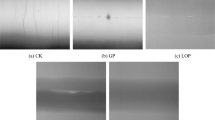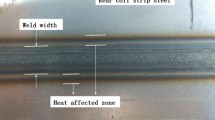Abstract
Weld defect recognition plays an important role in the manufacturing process of large-scale equipment. Traditional methods generally include several serial steps, such as image preprocessing, region segmentation, feature extraction, and type recognition. The results of each step have significant impact on the accuracy of the final defect identification. The convolutional neural network (CNN) has strong pattern recognition ability, which can overcome the above problem. However, there are two problems: one is that the pooling strategy has poor dynamic adaptability and the other is the insufficient feature selection ability. To overcome these problems, we propose a CNN-based weld defect recognition method, which includes an improved pooling strategy and an enhanced feature selection method. According to the characteristics of the weld defect image, an improved pooling strategy that considers the distribution of the pooling region and feature map is introduced. Additionally, in order to enhance the feature selection ability of the CNN, an enhanced feature selection method integrating the ReliefF algorithm with the CNN is proposed. A case study is presented for demonstrating the proposed techniques. The results show that the proposed method has higher accuracy than the traditional CNN method, and establish that the proposed CNN-based method is successfully applied for weld defect recognition.











Similar content being viewed by others
Abbreviations
- CNN:
-
Convolutional neural networks
- ReliefF:
-
Feature selection algorithm
- SVM:
-
Support vector machine
- CGP:
-
Cartesian genetic programming
- HD-CNN:
-
Hierarchical Deep Convolutional Neural Network
- P-CNN:
-
Pose-based Convolutional Neural Network
- RNN:
-
Recurrent Neural Network
- DCNN:
-
Deep Convolutional Neural Network
- ResNet:
-
Residual network
- RCNN:
-
Region Convolutional Neural Network
- ROI:
-
Region of interest
- F ij :
-
Input image
- n :
-
Moving step
- S :
-
Feature values obtained after pooling
- σ P :
-
Value in the pooling region
- σ FM :
-
Variance of the values on the feature map
- t min :
-
Minimum value in the pooling region
- t max :
-
Maximum value in the pooling region
- t ave :
-
Average value considering the maximum and minimum values in the pooling region
- μ :
-
Based on the max pooling strategy
- R :
-
From the training sample set at a time
- W(A):
-
Weight of each feature
- m :
-
Number of samples
- M j(C):
-
jth nearest neighboring sample in different categories of C
- p(C):
-
Proportion of class C samples in the total
- Class(R i):
-
Category to which Ri belongs
- diff(A, R i, R j):
-
Distance between Ri and Rj
- C n :
-
Samples selected in category C
- C m :
-
Total samples selected in all the categories
- PO:
-
Porosity
- SL:
-
Slag inclusion
- LF:
-
Lack of fusion
- LP:
-
Lack of penetration
- CR:
-
Crack
References
Zhang Z, Chen S (2017) Real-time seam penetration identification in arc welding based on fusion of sound, voltage and spectrum signals[J]. J Intell Manuf 28(1):207–218. https://doi.org/10.1007/s10845-014-0971-y
He K, Li X (2016) A quantitative estimation technique for welding quality using local mean decomposition and support vector machine[J]. J Intell Manuf 27(3):525–533. https://doi.org/10.1007/s10845-014-0885-8
Chady T, Sikora R, Misztal L, Grochowalska B, Grzywacz B, Szydłowski M, Waszczuk P, Szwagiel M (2017) The application of rough sets theory to design of weld defect classifiers. J Nondestruct Eval 36(2):40. https://doi.org/10.1007/s10921-017-0420-x
Liao Z, Sun J (2013) Image segmentation in weld defect detection based on modified background subtraction. Proceedings of the 2013 6th International Congress on Image and Signal Processing (CISP): 610-615. https://doi.org/10.1109/CISP.2013.6745239
Lim TY, Ratnam MM, Khalid MA (2007) Automatic classification of weld defects using simulated data and an MLP neural network. Insight Non-Destruct Test Cond Monit 49(6):154–159. https://doi.org/10.1784/insi.2007.49.3.154
Nacereddine N, Ziou D, Hamami L (2013) Fusion-based shape descriptor for weld defect radiographic image retrieval. Int J Adv Manuf Technol 68(9–12):2815–2832. https://doi.org/10.1007/s00170-013-4857-5
Jiang H, Zhao Y, Gao J, Wang Z (2016) Weld defect classification based on texture features and principal component analysis. Insight Non-Destruct Test Cond Monit 58(4):194–200. https://doi.org/10.1784/insi.2016.58.4.194
Goumeidane AB, Bouzaieni A, Nacereddine N et al (2015) In: Azzopardi G, Petkov N (eds) Bayesian networks-based defects classes discrimination in weld radiographic images. Computer Analysis of Images and Patterns- Proceedings of 16th International Conference (CAIP), vol 9257, Valletta, pp 554–565. https://doi.org/10.1007/978-3-319-23117-4_48
Mekhalfa F, Nacereddine N (2014) Multiclass classification of weld defects in radiographic images based on support vector machines. Proceedings of Tenth International Conference on Signal-Image Technology and Internet-Based Systems (SITIS):1-6. https://doi.org/10.1109/SITIS.2014.72
Jiang H, Wang R, Gao Z, Gao J, Wang H (2019) Classification of weld defects based on the analytical hierarchy process and Dempster–Shafer evidence theory. J Intell Manuf 30(4):2013–2024. https://doi.org/10.1007/s10845-017-1369-4
Lu H, Zhang M, Liu Y, Ma S (2017) Convolution neural network feature importance analysis and feature selection enhanced model. J Softw 28(11):2879–2890 (in Chinese). https://doi.org/10.13328/j.cnki.jos.005349
Juefei-Xu F, Boddeti V N, Savvides M (2017) Local binary convolutional neural networks. Proceedings of 30th IEEE Conference on Computer Vision and Pattern Recognition (CVPR 2017):4284-4293. https://doi.org/10.1109/CVPR.2017.456
Tokozume Y, Harada T (2017) Learning environmental sounds with end-to-end convolutional neural network. Proceedings of 2017 IEEE International Conference on Acoustics, Speech and Signal Processing (ICASSP):2721-2725. https://doi.org/10.1109/ICASSP.2017.7952651
Ghazaei G, Alameer A, Degenaar P et al (2017) Deep learning-based artificial vision for grasp classification in myoelectric hands. J Neural Eng 14(3):036025. https://doi.org/10.1088/1741-2552/aa6802
Liu K, Niu Y, Yang J et al (2016) Product related information sentiment-content analysis based on convolutional neural networks for the Chinese micro-blog. Proceedings of 2016 International Conference on Network and Information Systems for Computers (ICNISC):357-361. https://doi.org/10.1109/ICNISC.2016.083
He K, Zhang X, Ren S, Sun J (2015) Spatial pyramid pooling in deep convolutional networks for visual recognition. IEEE Trans Pattern Anal Mach Intell 37(9):1904–1916. https://doi.org/10.1109/TPAMI.2015.2389824
Zhang Z, Chen D, Wang J, Bai L, Hancock ER (2018) Quantum-based subgraph convolutional neural networks. Pattern Recogn 88:38–49. https://doi.org/10.1016/j.patcog.2018.11.002
Suganuma M, Shirakawa S, Nagao T (2017) A genetic programming approach to designing convolutional neural network architectures. Proceedings of the Genetic and Evolutionary Computation Conference (GECCO’17):497-504. https://doi.org/10.1145/3071178.3071229
Yan Z, Zhang H, Piramuthu R, et al (2016) HD-CNN: hierarchical deep convolutional neural networks for large scale visual recognition. Proceedings of 2015 IEEE International Conference on Computer Vision (ICCV):2740-2748. https://doi.org/10.1109/ICCV.2015.314
Kokkinos I (2017) UberNet: training a universal convolutional neural network for low-, mid-, and high-level vision using diverse datasets and limited memory. Proceedings of 30th IEEE Conference on Computer Vision and Pattern Recognition (CVPR):5454-5463. https://doi.org/10.1109/CVPR.2017.579
Chéron G, Laptev I, Schmid C (2015) P-CNN: pose-based CNN features for action recognition. Proceedings of 2015, IEEE International Conference on Computer Vision (ICCV): 3218-3226. https://doi.org/10.1109/ICCV.2015.368
Chaturvedi I, Cambria E, Poria S et al (2016) Bayesian deep convolutional belief networks for subjectivity detection. Proceedings of 16th IEEE International Conference on Data Mining Workshops (ICDMW):916-923. https://doi.org/10.1109/ICDMW.2016.0134
Ha M, Byeon Y, Lee Y et al (2019) Selective deep convolutional neural network for low cost distorted image classification. IEEE Access 7:133030–133042. https://doi.org/10.1109/ACCESS.2019.2939781
Wang J, Yang Y, Mao J et al (2016) CNN-RNN: a unified framework for multi-label image classification. Proceedings of 29th IEEE Conference on Computer Vision and Pattern Recognition (CVPR):2285-2294. https://doi.org/10.1109/CVPR.2016.251
Wu X, He R, Sun Z, Tan T (2018) A light CNN for deep face representation with noisy labels. IEEE Trans Inf Forensics Secur 13(11):2884–2896. https://doi.org/10.1109/TIFS.2018.2833032
Alom MZ, Hasan M, Yakopcic C (2020) Improved inception-residual convolutional neural network for object recognition. Neural Comput & Applic 32(1):279–293. https://doi.org/10.1007/s00521-018-3627-6
Abdulnabi AH, Wang G, Lu J, Jia K (2015) Multi-task CNN models for attribute prediction. IEEE Trans Multimedia 17(11):1949–1959. https://doi.org/10.1109/TMM.2015.2477680
Chen J, Patel VM, Chellappa R (2016) Unconstrained face verification using deep CNN features. 2016 IEEE Winter Conference on Applications of Computer Vision (WACV):7477557. https://doi.org/10.1109/WACV.2016.7477557
Khumaidi A, Yuniarno EM, Purnomo MH (2017) Welding defect classification based on convolution neural network (CNN) and Gaussian kernel. Proceedings of 2017 International Seminar on Intelligent Technology and Its Applications (ISITIA):261-265. https://doi.org/10.1109/ISITIA.2017.8124091
Liu B, Zhang X, Gao Z et al (2017) In: Zhai G, Zhou J, Yang X (eds) Weld defect images classification with VGG16-based neural network. Communications in Computer and Information Science - Proceedings of 14th International Forum on Digital TV and Wireless Multimedia Communications (IFTC), Singapore, pp 215–223. https://doi.org/10.1007/978-981-10-8108-8_20
Kumar et al (2020) Improved deep convolution neural network (CNN) for the identification of defects in the centrifugal pump using acoustic images. Appl Acoust 167. https://doi.org/10.1016/j.apacoust.2020.107399
Yuan et al (2020) Research on pipe surface defect recognition based on convolutional neural network. Modern Electron Tech:47–51. https://doi.org/10.16526/j.cnki.11-4762/tp.2020.06.038
Xie et al (2020) Classification and recognition method of sheet metal parts surface defects based on convolution neural network. Comput Meas Control:187–190+196. https://doi.org/10.16526/j.cnki.11-4762/tp.2020.06.038
Fan D et al (2020). X-ray image defect recognition method for pipe weld based on improved convolutional neural network. Hanjie Xuebao,7-11. https://doi.org/10.12073/j.hjxb.20190703002
Miao et al (2019) Online defect recognition of narrow overlap weld based on two-stage recognition model combining continuous wavelet transform and convolutional neural network. Comput Ind:112. https://doi.org/10.1016/j.compind.2019.07.005
Li et al (2019) Recognition of X-ray weld defects based on deep learning. J Xi’an Shiyou Univ (Nat Sci Ed):74–81. https://doi.org/10.3969/j.issn.1673-064X.2019.04.012
Tareef A, Song Y, Huang H, Wang Y, Feng D, Chen M, Cai W (2017) Optimizing the cervix cytological examination based on deep learning and dynamic shape modeling. Neurocomputing 248:28–40. https://doi.org/10.1016/j.neucom.2017.01.093
Gore S, Govindaraju V (2016) In: Skulimowski A, Kacprzyk J (eds) Feature selection using cooperative game theory and relief algorithm. advances in intelligent systems and computing - knowledge, information and creativity support systems: recent trends, advances and solutions (KICSS), Cham, pp 401–412. https://doi.org/10.1007/978-3-319-19090-7_30
Reyes O, Morell C, Ventura S (2015) Scalable extensions of the ReliefF algorithm for weighting and selecting features on the multi-label learning context. Neurocomputing 161:168–182. https://doi.org/10.1016/j.neucom.2015.02.045
Funding
This paper was supported by the National Key Research and Development Program of China (2017YFF0210502), Natural Science Basic Research Plan in Shaanxi Province of China (Program No. 2019JM-214), Research and Application of TOFD Detection Technology for Fusion Welded Butt Joint of Titanium Pressure Equipment (2019KY05), and the fund of the Service Quality Assessment and Management of Pressure Vessels in Process Industry (3211000781).
Author information
Authors and Affiliations
Corresponding author
Ethics declarations
Conflict of interest
The authors declare that they have no conflict of interest.
Additional information
Publisher’s note
Springer Nature remains neutral with regard to jurisdictional claims in published maps and institutional affiliations.
Recommended for publication by Commission XVIII - Quality Management in Welding and Allied Processes
Rights and permissions
About this article
Cite this article
Jiang, H., Hu, Q., Zhi, Z. et al. Convolution neural network model with improved pooling strategy and feature selection for weld defect recognition. Weld World 65, 731–744 (2021). https://doi.org/10.1007/s40194-020-01027-6
Received:
Accepted:
Published:
Issue Date:
DOI: https://doi.org/10.1007/s40194-020-01027-6




